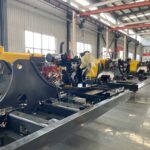Introduction
Dozers, also known as bulldozers, are powerful and versatile heavy equipment used in construction, mining, forestry, and more. At the heart of these mighty machines lies a complex system of components known as dozer parts that work together to get the job done.
From blades and tracks to engines and hydraulics, dozer parts come in a wide variety of shapes and sizes. While some facts about these parts, like their sheer size and strength, may be common knowledge, there are likely many obscure details and “fun facts” about dozer parts that you’ve never heard before.
In this blog post, we’ll highlight ten fascinating facts you probably didn’t know about the inner workings and components that give dozers their unparalleled power and efficiency on the job site. Read on to learn insider info on dozer cutting edges, final drive components, and much more.
Dozer Blades Can Weigh Around 5,000 Pounds
The massive front blade that bulldozers use to push, scrape, and move material is far heavier than you probably realize. On large dozers, these rugged blades can measure over 20 feet long and weigh a staggering 5,000 pounds or more!
These heavy-duty moldboard blades consist of sturdy steel plate reinforced by large ribs for added strength and durability. Heavy-duty blade tilting cylinders and mounting hardware also add to the overall weight. No wonder dozers have so much push power!
Table 1: Approximate Weights of Dozer Blades
| Blade Size | Weight |
|---|---|
| 12-foot | 2,500 lbs |
| 16-foot | 4,000 lbs |
| 20-foot | 5,000+ lbs |
Some Dozer Tracks Have Shoes That Weigh Over 130 Pounds Each

The tracks that propel bulldozers and allow them to operate on rough terrain are made up of many durable components. The track shoes (also called grouser shoes) that protect the track links and provide grip and flotation are particularly formidable in size and weight.
On large mining dozers like the Caterpillar D11, each shoe can weigh a staggering 130 lbs or more! With dozens of track shoes per side, you can understand why bulldozer tracks alone can weigh 15 tons or more. The extreme pounds per square inch (PSI) of even small dozers underscore why proper operation is crucial to avoiding damage.
Final Drive Components Can Cost Over $100,000 to Replace

The final drives on tracked equipment like bulldozers are gearboxes that provide the extreme torque and power needed to drive the heavy tracks. They contain hardened steel gears submerged in oil baths and are engineering marvels.
But when they wear out or break down, replacing final drive components costs as much as a luxury sports car! Because of intricate labor and parts, final drive rebuilds often exceed $100,000. Proper maintenance like frequent oil changes can help prevent expensive failures.
Hydraulic Pumps Can Generate Over 4,000 PSI of Pressure
The hydraulic systems that power implement functions, steering, and travel on dozers need incredibly high fluid pressure and flow rate capacity to handle heavy workloads. On a Caterpillar D11 dozer, for example, the implement pump generates a staggering 4,000 PSI (Pounds per Square Inch) during demanding operations like hard digging.
In comparison, a typical passenger vehicle power steering system operates at around 1,200 PSI or less. Dozer hydraulic pressure levels highlight the extreme forces within these systems. Proper maintenance of hydraulic pumps, cylinders, valves, and lines is critical. A tiny leak under thousands of PSI can easily turn into a dangerous jet of hydraulic fluid.
Radiators Help Coolant Temperatures Exceed 200 Degrees
The radiator on a bulldozer has the vital job of cooling the large diesel engine’s coolant to safe operating temperatures even under extreme loads. To handle the massive heat generated by over 500 peak horsepower, dozer cooling systems allow coolant temperatures over 200 degrees Fahrenheit before triggering warnings.
That may seem excessively hot compared to a car engine’s 180-220 degree threshold, but it shows how hardy dozer powerplant components are. Coolant also needs this heat to properly cycle through the cooling jackets around cylinders and heads. High-capacity water pumps and cooling fans ensure temperatures don’t climb too high even on the toughest jobs.
Conclusion
In the right hands — or perhaps “blades” — bulldozers rank among the most versatile and formidable machines in the world. These rugged beasts make short work of earthmoving and material handling challenges thanks to their pure power and advanced engineering across every component.
And as the facts above illustrate, vital dozer parts like blades, undercarriage elements, powertrain components, and more represent the pinnacle of durable mechanical design. Now when you see dozers hard at work, you can better appreciate all the “muscle behind the muscle” in terms of remarkable hydraulics, cooling capacity, gearbox strength, and power generation.
The next time you operate heavy equipment, remember the amazing capabilities built into every pin, piston, gear, and gasket — not to mention the tremendous scale of things like blade rigidity and track shoe tonnage. Respect for dozers should begin with respect for the smaller pieces and systems making their legendary productivity possible in the first place!
FAQ
Q: How often should dozer parts like blades and drawbars be inspected or replaced?
A: Front attachments like blades and ripper drawbars should be thoroughly inspected daily for cracks or damage per the operator’s manual. Based on wear and tear, complete blade/drawbar replacements may be needed every 1-2 years.
Q: What is the hardest or most expensive dozer component to service?
A: Final drives often require highly-specialized mechanics and repairs exceeding $100k. Rebuilds or replacements of engines, pumps, and powertrain elements are also very labor-intensive and costly.
Q: Can worn dozer parts like tracks be reconditioned to extend service life?
A: Yes, work tools like blades along with drivetrain elements like sprockets and rollers can be reconditioned to manufacturer specs, saving significantly on replacement costs. Track shoes can also be rotated front-to-back and replaced individually as needed. Proper component reconditioning relies heavily on experienced mechanics.
Q: How much can a dozer blade tilt?
A: Bulldozer blades can tilt quite dramatically — as much as 25-30 degrees in either direction through hydraulic cylinders. This allows operators to roll material sideways up slopes or down into trenches. The right tilt angle also aids penetration and carrying capacity.





-150x150.webp)
